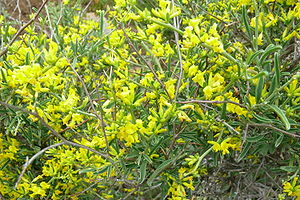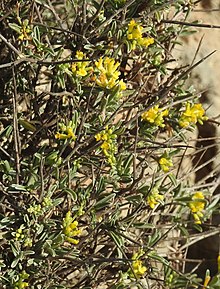Thorny wound clover
| Thorny wound clover | ||||||||||||
|---|---|---|---|---|---|---|---|---|---|---|---|---|

Thorny kidney vetch ( Anthyllis hermanniae subsp. Hermanniae ) |
||||||||||||
| Systematics | ||||||||||||
|
||||||||||||
| Scientific name | ||||||||||||
| Anthyllis hermanniae | ||||||||||||
| L. |
The Thorny Wundklee ( Anthyllis hermanniae ) is a plant of the genus Wundklee ( Anthyllis ).
features
The thorny wound clover is a low, sparsely branched thorn bush that reaches heights of 10 to 50 centimeters. The branches are twisted. Young branches are hairy, older ones are more or less bare and end in a thorn. The leaves are simple or threefold. The feathers are elongated, narrow and often folded and, especially on the underside, silk-haired. They reach a length of 1 to 2 centimeters.
The flowers are usually arranged in twos to five in the leaf axils , but can rarely be single. They form a long, interrupted inflorescence . The crown is 6 to 9 millimeters long, curved and yellow. The cup is 3 to 5 millimeters in size. The five approximately equal calyx teeth are shorter than the silky-haired calyx tube. The fruit is 2 to 3 millimeters in size, egg-shaped, glabrous and single-seeded.
The flowering period extends from April to July.
The chromosome number is different from all subspecies except subsp. melitensis and subsp. sicula is known and is 2n = 14 in each case.
Occurrence
The thorny wound clover occurs in southern Europe and Asia Minor in Garigues .

Systematics
The Thorny Wundklee was in 1753 by Linnaeus in Species Plantarum as Anthyllis hermanniae L. first published . The epithet refers to the similarity of the Thorny wound clover genus of South African plants Hermannia L. of the mallow family (Malvaceae), which used to Sterkuliengewächsen was placed (Sterculiaceae). This genus in turn was named in honor of the German-Dutch doctor and botanist Paul Hermann (1640–1695).
It occurs in a relatively large, contiguous sub-area in the eastern Mediterranean, but in the central Mediterranean in diverse, disjoint populations with different location requirements, which can be divided into the following subspecies:
- Anthyllis hermanniae subsp. brutia Brullo & Giusso , represents the species in Calabria , where it has only one locality.
- Anthyllis hermanniae subsp. corsica Brullo & Giusso , occurs in Corsica up to high mountain regions on silicate.
- Anthyllis hermanniae L. subsp. hermanniae , is widespread in the northeastern Mediterranean region and occurs in Montenegro , Albania , Greece , the Aegean Islands, Crete and western Anatolia .
- Anthyllis hermanniae subsp. ichnusae Brullo & Giusso , occurs on limestone in central mountain areas of Sardinia .
- Anthyllis hermanniae subsp. japygica Brullo & Giusso , occurs in Apulia and is also only known from one site there.
- Anthyllis hermanniae subsp. melitensis Brullo & Giusso , occurs only on Malta , Gozo and Comino .
- Anthyllis hermanniae subsp. sicula Brullo & Giusso , This subspecies occurred on the south coast of Sicily until the 19th century and is considered extinct.
A closely related taxon , formerly regarded as a variety of Anthyllis hermanniae , is the species Anthyllis hystrix (Welcome ex Barceló) Cardona, Contandriopoulos & Sierra (Syn .: Anthyllis hermanniae var. Hystrix Welcome ex Barceló ) from Menorca .
Individual evidence
- ↑ a b c d Peter Schönfelder , Ingrid Schönfelder: What blooms on the Mediterranean? (= Kosmos nature guide ). 1st edition. Franckh, Stuttgart 1987, ISBN 3-440-05790-9 .
- ↑ a b c d e f g h i j Salvatore Brullo, Gianpietro Giusso del Galdo: Taxonomic Remarks on the Anthyllis hermanniae L. (Fabaceae, Faboideae) Species Complex of the Mediterranean Flora. In: Novon. Volume 16, No. 3, 2006, pp. 304-314 ( digitized version ).
- ↑ Carl von Linné: Species Plantarum. Volume 2, Lars Salvius, Stockholm 1753, p. 720 ( digitized ).
- ^ Sandro Pignatti (ed.): Flora d'Italia . Vol. 1. Edagricole, Bologna 2003, ISBN 88-506-2449-2 , pp. 750 (third unaltered reprint of the 1st edition from 1982).
- ↑ Helmut Genaust: Etymological dictionary of botanical plant names. 3rd, completely revised and expanded edition. Nikol, Hamburg 2005, ISBN 3-937872-16-7 , p. 286 (reprint from 1996).
